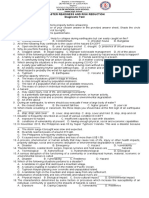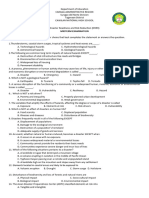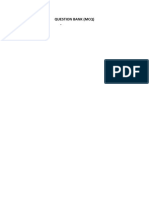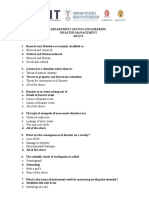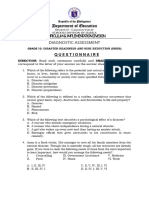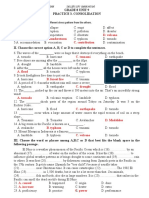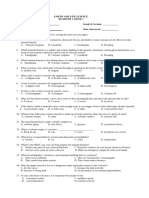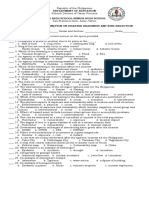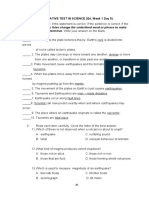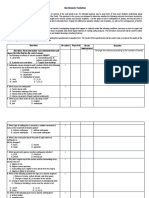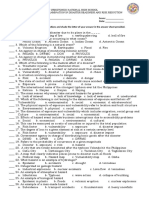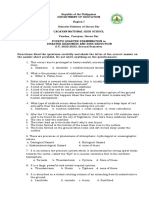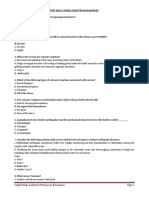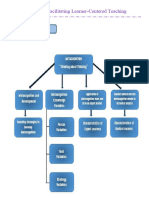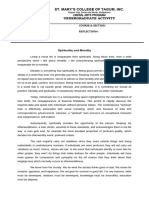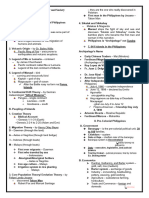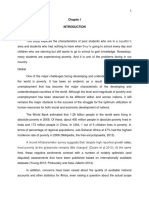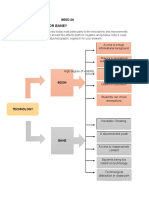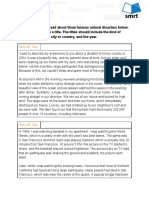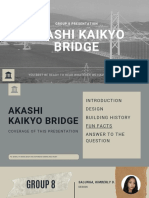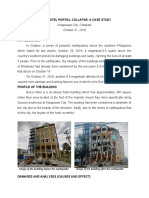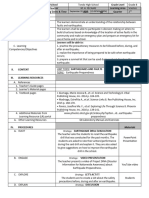0 ratings0% found this document useful (0 votes)
51 viewsDRRR - Parallel-Assessment-Q3 Anne
DRRR - Parallel-Assessment-Q3 Anne
Uploaded by
angelica barruelaThis document contains a 50-item multiple choice exam on disaster readiness and risk reduction. The exam tests knowledge of different natural hazards like earthquakes, volcanoes, and tsunamis. It addresses topics like the causes and effects of disasters, how vulnerability varies in different locations, and safety precautions for various hazard scenarios. The exam also covers man-made hazards and how disasters impact environments and societies.
Copyright:
© All Rights Reserved
Available Formats
Download as DOCX, PDF, TXT or read online from Scribd
DRRR - Parallel-Assessment-Q3 Anne
DRRR - Parallel-Assessment-Q3 Anne
Uploaded by
angelica barruela0 ratings0% found this document useful (0 votes)
51 views6 pagesThis document contains a 50-item multiple choice exam on disaster readiness and risk reduction. The exam tests knowledge of different natural hazards like earthquakes, volcanoes, and tsunamis. It addresses topics like the causes and effects of disasters, how vulnerability varies in different locations, and safety precautions for various hazard scenarios. The exam also covers man-made hazards and how disasters impact environments and societies.
Original Description:
ASSESSMENT
Original Title
DRRR_PARALLEL-ASSESSMENT-Q3 ANNE
Copyright
© © All Rights Reserved
Available Formats
DOCX, PDF, TXT or read online from Scribd
Share this document
Did you find this document useful?
Is this content inappropriate?
This document contains a 50-item multiple choice exam on disaster readiness and risk reduction. The exam tests knowledge of different natural hazards like earthquakes, volcanoes, and tsunamis. It addresses topics like the causes and effects of disasters, how vulnerability varies in different locations, and safety precautions for various hazard scenarios. The exam also covers man-made hazards and how disasters impact environments and societies.
Copyright:
© All Rights Reserved
Available Formats
Download as DOCX, PDF, TXT or read online from Scribd
Download as docx, pdf, or txt
0 ratings0% found this document useful (0 votes)
51 views6 pagesDRRR - Parallel-Assessment-Q3 Anne
DRRR - Parallel-Assessment-Q3 Anne
Uploaded by
angelica barruelaThis document contains a 50-item multiple choice exam on disaster readiness and risk reduction. The exam tests knowledge of different natural hazards like earthquakes, volcanoes, and tsunamis. It addresses topics like the causes and effects of disasters, how vulnerability varies in different locations, and safety precautions for various hazard scenarios. The exam also covers man-made hazards and how disasters impact environments and societies.
Copyright:
© All Rights Reserved
Available Formats
Download as DOCX, PDF, TXT or read online from Scribd
Download as docx, pdf, or txt
You are on page 1of 6
TAGUM CITY NATIONAL HIGH SCHOOL
SENIOR HIGH SCHOOL
FIRST QUARTER EXAMINATION
SECOND SEMESTER (S.Y. 2021-2022)
DISASTER READINESS AND RISK REDUCTION
Name: ___________________________Date: ________ Section: _______Score: _________
GENERAL INSTRUCTIONS:
1. This exam contains 50 multiple choice questions.
2. Write the letter of your answer on the space provided before each item.
3. Strictly NO ERASURES or any form of alteration allowed.
4. Use only black- or blue-inked ballpens. No using of friction pen and pencil.
__D__ 1. Which of the following is a natural hazard?
A. Earthquake B. Landslide C. Cyclone D. All of the above
__C__ 2. The following below speak about disaster, except:
A. a typhoon that caused severe flooding and affected hundreds of people in a certain
barangay
B. a severe earthquake that led to the collapse of houses, burying household members
C. a community hit by an earthquake but resumes daily setting normally
D. epidemic
__B__ 3. One of the impacts of disaster is the direct losses someone incurs after the
occurrence of a particular hazard event. Direct losses include
A. disrupting or damaging utility services or local business
B. destruction and changes that reduce the functionality of an individual or structure
C. psychological challenges
D. none of the above
__C__ 4. Which of the following statements is NOT true?
A. Earthquakes continually pose as a threat to Filipinos, and have been part of the
Filipino consciousness due to its prevalence in the past decades.
B. Volcanoes significantly shaped and continuously shape the earth’s surface and the
way how people live over time.
C. Disasters are often defined by consequences to human lives and not on the basis of
the disaster itself.
D. The prevalence of disaster is a major national concern.
__B__ 5. Volcanoes are generally found where
A. Intraplates pull apart or are coming together
B. Tectonic plates pull apart or are coming together
C. Earth's crust pull apart or are coming together
D. None of these pull apart or are coming together
__C__ 6. A hazard originating from technological or industrial conditions is known as
A. Natural Hazard C. Man-made Hazard
B. Geological Hazard D. Hydrometeorological Hazard
__C__ 7. Which of the following is not a man-made hazard?
A. Leakage of Toxic waste C. Drought
B. Wars and Civil Strife D. Environmental pollution
__B__ 8. The zone of the earth that is divided into rigid plates is the .
A) atmosphere B) lithosphere C) tectosphere
D) biosphere
__C__ 9. The actual effects and damages made by an earthquake is referred to as
A. Magnitude B. Intensity C. Hazard D. Disaster Risk
__C__ 10. The most active and destructive volcanoes are nestled at the
A. Pacific Rim B. Pacific Ream C. Pacific Ocean D. Asia Pacific
__C__ 11. Fault or discontinuity is formed when
A. earth experienced intense rainfall
B. there is a continuous movement of earth’s rocks
C. pressure is released due to movement of earth’s plates
D. two tectonic plates converge with one another
__A__ 12. Which of the following is/are observed after a volcanic eruption?
A. the more the lava that comes out, the taller and wider the volcano gets
B. new mountains and landscapes are formed
C. gases emitted by volcanoes have impacted the atmosphere, creating seascapes
D. All of the above
__C__ 13. The kind of volcano that has not erupted within historic times and is not expected to
erupt again in a comparable time scale of the future is known as
A. Dormant Volcano B. Erupting Volcano C. Extinct Volcano D. Active
Volcano
__D__ 14. The level of risk of a disaster depends on
a. Nature of the hazard
b. Vulnerability of the elements which are affected
c. Economic value of the elements which are affected
d. All of the above
__A__ 15. The most dangerous and powerful kind of earthquake is known as
A. Plutonic earthquake C. Ground earthquake
B. Volcanic earthquake D. Tectonic earthquake
__C__ 16. Which of the following statements below is FALSE?
A. A tsunami is most often caused by undersea earthquakes.
B. If a small tsunami is coming, I should get out of the water and wait until I hear it is
safe to return.
C. If I felt a strong earthquake while near the coast, I should wait to hear the rumbling
sound before moving to high ground.
D. I could get dragged out to the sea by strong rips and currents should I caught by
small tsunamis while swimming.
__A__ 17. The fragments of volcanic rock ejected into air by explosion is termed as
A. Tephra B. Ashfalls C. Gas emissions D. Pyroclastic flow and
surges
__D__ 18. The following are commonly observed signs that a volcano is about to erupt, except:
A. Increase in the frequency of volcanic quakes with rumbling sounds
B. Increase in the temperature of hot springs, wells near the volcano
C. Crater glows due to presence of magma at or near the crater
D. Geophysical and geochemical characteristics of a volcano remain unchanged.
__B__ 19. A serious and tragic event that includes the loss of lives and great damages to
properties is
A. Disaster Risk B. Disaster C. Exposure D. Adaptive capacity
__B__ 20. One family is living on a mountain slope. The other family is in the urban area. Given
these families
are hit by the same intense level of rainfall, definitely the former will most likely get affected
severely
rather than the latter. Which of the following best explains the idea?
I. Both houses are susceptible but only the former is vulnerable.
II. Vulnerability of the exposure is dependent on the location and that it varies spatially.
III. No damage or loss can take place if only the former transferred to the city.
IV. Extreme rainfall should not be enough to destroy families living in mountain slopes.
A. I & IV B. I & II C. I only D. II only
__C__ 21. The process in which soft and sandy soils can behave like a fluid during an
earthquake is called
A. Ground Shaking B. Water Disturbance C. Liquefaction D. Sinkholes
__A__ 22. When a certain community is hit by a magnitude 5.5 to 6 brought about by an
earthquake, the possible effects would be
A. Slight damage to buildings and other structures
B. Serious damage
C. A lot of damage in very populated areas
D. No damages at all
__B__ 23. The instrument which records earthquake wave is called
A) Climograph B) Seismograph C) Hythergraph D) None of the
above
__C__ 24. What is it called when a large number of people in a community get a disease at the
same time?
A) Influx B) Black death C) Epidemic D) Pandemic
__B__ 25. A volcano that has not erupted within the last 10,000 years can be classified as
A. Active Volcano B. Extinct Volcano C. Dormant Volcano D. Erupting
Volcano
__B__ 26. The location below the earth’s surface where the earthquake starts is called
A. Focus B. Epicenter C. Surface Center D. Control
Center
__D__ 27. The following are the things you should follow to make you and your family safe from
volcano hazards, except:
A. Make a detailed emergency plan.
B. Develop a communication mechanism.
C. Strengthen roof’s houses
D. Leave important documents in the house first.
__B__ 28. A type of volcano hazard that is composed of rock material, hot gas, and ash that
move above ground surface at high velocities is termed as
A. Gas emissions B. Pyroclastic flow C. Ashfall D. Tephra
__C__ 29. Which of the following is not true about the impacts of disaster to the environment?
A. Flood can have a negative impacts on trees and root crops if submerged for a long
time.
B. Drought damages ecosystem because it reduces water supply which is essential for
survival.
C. Floods can nourish the soil and provide fresh supplies of water, nutrients, and
sediments.
D. A tsunami can destroy properties and brings high toll of death but could not devastate
ecological habitats.
__A__ 30. Bioterrorism is an example of
A. Biological Hazard B. Man-made disaster C. Exposure D. Disaster
Risk
__B__ 31. The vibration that is generated by a sudden impulse in the earth such as earthquake
is known as
A. Seismograph B. Seismic Waves C. Pressure Waves D. Energy Waves
__C__ 32. Ultimate consequences of war are
A. Decline in human population C. Rise in refugees
B. Outbreak of diseases and epidemics D. All of the above
__B__ 33. In the Philippines, one of the most feared earthquakes might happen along the West
Valley Fault. It has a dextral strike-slip fault system that extends from Rizal to Taguig City.
Experts describe this as the
A. Big All B. Big One C. Mega Earthquake D. Shocking
earthquake
__A__ 34. Which one of the following is a geological disaster?
A. Tsunami B. Storm surge C. Flood D. Wild fire
__C__ 35. The opening or vent of a volcano is called
A. Magma B. Lava C. Crater D. Pipe
__C__ 36. Also known as “Molten Rocks” beneath the earth surface.
A. Lava B. Ashfall C. Magma D. Crater
__C__ 37. Which of the following is the thing you should not keep in mind after a big
earthquake?
A. Check for injuries and if there are, then call for an immediate medical assistance.
B. Be cautious of the damaged buildings and stay away from downed lines.
C. Take pictures of the damaged areas of your house, cars that can be used for
insurance claims.
D. Drop. Cover. Hold.
__D__ 38. It is formed due to pyroclastic flow mixed with water, snow mixed with debris, and
rainfall on ash.
A. Pyroclastic flow and surges B. Tephra falls C. Ballistic Projectiles
D. Lahar
__D__ 39. The role of Volcanology is to
A. gain an understanding of how Volcanoes work
B. further scientific knowledge of Volcanoes
C. provide eruption hazard assessment, monitoring, and crisis management
D. All of the above
__D__ 40. The magnitude of an earthquake is measured using
A. Richer Scale B. Richter Scale C. Weighing Scale D.
Seismograph
__A__ 41. Natural phenomena like typhoon and earthquake are considered as
A. Risks B. Hazards C. Emergency D. Vulnerability
__D__ 42. Disasters frequently result in all of the following EXCEPT
A. Damage to the ecological environment
B. Displacement of populations
C. Destruction of a population"s homeland
D. Sustained public attention during the recovery phase
__D__ 43. Appropriate environmental management can reduce the risk of disasters occurring
by
A. Improving coastal management and flood risk reduction
B. Reducing risk of drought, sand storm and hazardous fires
C. Regulating flood waters
D. All of the above
__D__ 44. Social workers skilled in crisis management work:
A. violent events such as child abuse, domestic abuse, crime
B. psychopathology that triggers a crisis i.e. suicide attempt, drug overdose
C. car accident, life-threatening illness
D. With all of the above
__C__ 45. The process where two tectonic plates converge one another, with one descending
below the edge of the other, causing molten rock to rise to the surface forming a volcano is
called
A. Subtraction B. Precipitation C. Subduction D. Volcano formation
__B__ 46. Of the following, which is not the root of a terrorist act and movement?
A. Poverty B. Equality C. Marginalization D. Power
__B__ 47.A series of high water waves triggered by disruptions of the seafloor is known as
A. Liquefaction C. Sea Avalanche
B. Tsunami D. Sea Waves
__C__ 48. The type of fault that moves along the direction of the dip plane is called
A. Strike-slip fault C. Dip-slip fault
B. Oblique-dip fault D. Normal fault
__B__ 49. Drop, cover, and hold are done
A. before an earthquake occurs C. after an earthquake
B. during an earthquake D. anytime if you want
__C__ 50. Tsunami is:
A. Earthquake on land mass B. Volcanic eruption
C. Earthquake in ocean crust D. None of these
“I can do all things thru Christ who
strengthens me.”
- Philippians 4:13
You might also like
- Blessed Christian School de Sta. Rosa Inc.: Rizal Blvd. Balibago, City of Santa Rosa SY: 2019-2020Document4 pagesBlessed Christian School de Sta. Rosa Inc.: Rizal Blvd. Balibago, City of Santa Rosa SY: 2019-2020Angelyn LingatongNo ratings yet
- DRRR Exam.Document7 pagesDRRR Exam.Claudette M.Magararu100% (1)
- DRRR Diagnostic TestDocument3 pagesDRRR Diagnostic TestJuliane Rebecca Pitlongay100% (1)
- DRRR ExamDocument15 pagesDRRR ExamElmer CarbonNo ratings yet
- First Quarter Examination-Second SemesterDocument3 pagesFirst Quarter Examination-Second Semesterchonamae.purisimaNo ratings yet
- Midterm Exam DRRR SY 2018-2019Document6 pagesMidterm Exam DRRR SY 2018-2019Jhen Barnard85% (34)
- Diagnostic ExamDocument6 pagesDiagnostic ExamLG Niegas100% (1)
- Midterm Exam DRRR SY 2018 2019Document6 pagesMidterm Exam DRRR SY 2018 2019Janix MagbanuaNo ratings yet
- DRR11Document8 pagesDRR11Llermi Liborio100% (1)
- DRRM - 1st Long QuizDocument3 pagesDRRM - 1st Long QuizFrancis BernalesNo ratings yet
- DRRR 1st Quarter ExamDocument5 pagesDRRR 1st Quarter ExamEMILY MAG-ALASIN100% (5)
- Q2 Midterm DRRRDocument2 pagesQ2 Midterm DRRRKrizle Jaica CalamareNo ratings yet
- DRRR1st ExamDocument4 pagesDRRR1st ExamJuliane Rebecca PitlongayNo ratings yet
- Grade 8 Regular Science 2nd QuarterDocument9 pagesGrade 8 Regular Science 2nd QuarterEverly Victorio SantosNo ratings yet
- 3rd Final ExamDocument9 pages3rd Final ExamMira Verano100% (1)
- PPPR3Document2 pagesPPPR3Pearl Cabigas50% (2)
- Fourthperiodicaltest DRRR 211125115444Document8 pagesFourthperiodicaltest DRRR 211125115444Bela RilloNo ratings yet
- Science 8 2ND QuarterDocument4 pagesScience 8 2ND Quarterjuliusvaldez07201996No ratings yet
- Quiz DRRRDocument3 pagesQuiz DRRRGlenn Cacho Garce100% (6)
- Els Final Exam 2018Document4 pagesEls Final Exam 2018MarvinNo ratings yet
- DRRRM Midterm Exam 2nd SemDocument3 pagesDRRRM Midterm Exam 2nd SemRenier Dela Vega FloresNo ratings yet
- NAME: - COURSE/SECTION: - SCORE: Long Quiz in DRRRDocument3 pagesNAME: - COURSE/SECTION: - SCORE: Long Quiz in DRRRRenz GaraisNo ratings yet
- DM QUESTION BAN1 DM MCQDocument21 pagesDM QUESTION BAN1 DM MCQuttkarsh vermaNo ratings yet
- 3rdquarter DRRRDocument5 pages3rdquarter DRRRCarlz BrianNo ratings yet
- Disaster Management QA - Docx SignedDocument8 pagesDisaster Management QA - Docx SignedSrijaJuluruNo ratings yet
- Name: - Date: - ScoreDocument3 pagesName: - Date: - ScoreJoben De Leon TuazonNo ratings yet
- DRRR ExamDocument4 pagesDRRR ExamShaira Bartido100% (1)
- DRRR - Midterm ExamDocument4 pagesDRRR - Midterm ExamAnonymous k3Ru5RZbw100% (1)
- Name: - Section: - Date: - ScoreDocument4 pagesName: - Section: - Date: - ScoreBRENDEL SACARISNo ratings yet
- Disaster Readiness and Risk Reduction Quarter ExamDocument5 pagesDisaster Readiness and Risk Reduction Quarter ExamLAURENCE CASILDONo ratings yet
- DRRDocument5 pagesDRRCristilyn SaagundoNo ratings yet
- Jarven DRRR Examination. First ExaminationDocument3 pagesJarven DRRR Examination. First ExaminationJarven SaguinNo ratings yet
- TQ - Q3 - Science 8Document5 pagesTQ - Q3 - Science 8MYLENE B. ZABALLERONo ratings yet
- Grade 12-DRRRDocument9 pagesGrade 12-DRRRMercy MangaoilNo ratings yet
- q4 DRRR 12 With AnswerDocument22 pagesq4 DRRR 12 With AnswerRonellaSabado100% (3)
- Grade 8 Unit 9 Practice 3. HSDocument4 pagesGrade 8 Unit 9 Practice 3. HSKhôi Nguyên ĐặngNo ratings yet
- Quiz 13 Geologic HazardsDocument2 pagesQuiz 13 Geologic Hazardslenit lazoNo ratings yet
- 3rd Quarter Exam DRRRDocument2 pages3rd Quarter Exam DRRRrichard babas100% (10)
- DRRR Module 11Document12 pagesDRRR Module 11royoadelineNo ratings yet
- DRRRM 25 QuestionsDocument4 pagesDRRRM 25 QuestionsLira PontillasNo ratings yet
- Week 1 Day 5 Summative Test in Science q4 w1Document4 pagesWeek 1 Day 5 Summative Test in Science q4 w1Michael Edward De VillaNo ratings yet
- Third Written Test in DRRR Q1Document8 pagesThird Written Test in DRRR Q1Jolmar A RudelaNo ratings yet
- 4th Periodic Test in Sci 5 With Tos RevisedDocument8 pages4th Periodic Test in Sci 5 With Tos RevisedJunrel CaneteNo ratings yet
- Unit 9 E8 3Document6 pagesUnit 9 E8 3Quỳnh PhạmNo ratings yet
- Quiz 14 HYDROMETEOROLOGICAL HAZARDSDocument2 pagesQuiz 14 HYDROMETEOROLOGICAL HAZARDSlenit lazoNo ratings yet
- Group 6 - Questionnaire EvaluationDocument7 pagesGroup 6 - Questionnaire EvaluationShella Mae V. AceboqueNo ratings yet
- EDITED - Q1 G11 Earth and Life Science SummativeDocument11 pagesEDITED - Q1 G11 Earth and Life Science SummativeTonet Salago CantereNo ratings yet
- 3rd DRRR EXAMDocument2 pages3rd DRRR EXAMMary Jane Tamondong Baniqued100% (2)
- DRRR q4 ExaminationDocument5 pagesDRRR q4 ExaminationLAURENCE CASILDO100% (1)
- Pointers To Review 1Document4 pagesPointers To Review 1janredzranaraNo ratings yet
- Midterm Exam DRRR Sy 2018 2019Document6 pagesMidterm Exam DRRR Sy 2018 2019carl manaayNo ratings yet
- Microsoft Word - Disaster Management MCQDocument23 pagesMicrosoft Word - Disaster Management MCQPrashant kambleNo ratings yet
- DRRR RTPDocument5 pagesDRRR RTPLyric BantilesNo ratings yet
- DRRR LAS Q1 W1 2nd Sem SY 2020 2021Document1 pageDRRR LAS Q1 W1 2nd Sem SY 2020 2021Mark Allen LabasanNo ratings yet
- PogiDocument3 pagesPogiEdrin BustosNo ratings yet
- DRRR 2nd Quarter TestDocument3 pagesDRRR 2nd Quarter Testlin mae tonaresNo ratings yet
- Midterm Exam DRRRDocument2 pagesMidterm Exam DRRRManuel Paulo AcogidoNo ratings yet
- Hell and High Water: Global Warming—the Solution and the Politics—and What We Should DoFrom EverandHell and High Water: Global Warming—the Solution and the Politics—and What We Should DoNo ratings yet
- Disaster Risk Reduction for the Built EnvironmentFrom EverandDisaster Risk Reduction for the Built EnvironmentRating: 1 out of 5 stars1/5 (1)
- Unraveling the Storm: A Chaotic Dance of Climate and ConflictFrom EverandUnraveling the Storm: A Chaotic Dance of Climate and ConflictNo ratings yet
- sAMPLE - RG1 - BSA4 - Cabilis Et Al. (Validation Form)Document3 pagessAMPLE - RG1 - BSA4 - Cabilis Et Al. (Validation Form)angelica barruelaNo ratings yet
- Pe 203 NotesDocument5 pagesPe 203 Notesangelica barruelaNo ratings yet
- St. Mary'S College of Tagum, Inc.: Undergraduate ActivityDocument2 pagesSt. Mary'S College of Tagum, Inc.: Undergraduate Activityangelica barruelaNo ratings yet
- Basic Vocabulary of Geometric FigureDocument5 pagesBasic Vocabulary of Geometric Figureangelica barruelaNo ratings yet
- 1st Demo SPED CWA LPDocument5 pages1st Demo SPED CWA LPangelica barruelaNo ratings yet
- History Timeline of BadmintonDocument10 pagesHistory Timeline of Badmintonangelica barruelaNo ratings yet
- Educ 104 NotesDocument10 pagesEduc 104 Notesangelica barruelaNo ratings yet
- Man Enslaved by Sin But Saved by GraceDocument2 pagesMan Enslaved by Sin But Saved by Graceangelica barruelaNo ratings yet
- Directions: Provide The Illustration of The Following.: ActivityDocument1 pageDirections: Provide The Illustration of The Following.: Activityangelica barruelaNo ratings yet
- Spirituality and MoralityDocument2 pagesSpirituality and Moralityangelica barruelaNo ratings yet
- Tle-2-M5l1-Barruela, Angelica C. Beed3aDocument14 pagesTle-2-M5l1-Barruela, Angelica C. Beed3aangelica barruelaNo ratings yet
- Scripture in MoralityDocument2 pagesScripture in Moralityangelica barruelaNo ratings yet
- Virtue EthicsDocument2 pagesVirtue Ethicsangelica barruelaNo ratings yet
- Gen Soc. L2 Gender Socialization and Gender StereotypesDocument11 pagesGen Soc. L2 Gender Socialization and Gender Stereotypesangelica barruelaNo ratings yet
- Readings of Philippine History and Society HandouthsDocument4 pagesReadings of Philippine History and Society Handouthsangelica barruelaNo ratings yet
- Eng 201Document8 pagesEng 201angelica barruelaNo ratings yet
- Chapter 2 - Lesson 2Document10 pagesChapter 2 - Lesson 2angelica barruelaNo ratings yet
- 1 s2.0 S0925231220308110 MainDocument12 pages1 s2.0 S0925231220308110 Mainangelica barruelaNo ratings yet
- Art Appreciatio HANDOUTSDocument5 pagesArt Appreciatio HANDOUTSangelica barruelaNo ratings yet
- Gen Soc. l2 Women A Sectoral SituationerDocument13 pagesGen Soc. l2 Women A Sectoral Situationerangelica barruelaNo ratings yet
- Gen Soc. C1L1 Sex Gender and Gender RolesDocument8 pagesGen Soc. C1L1 Sex Gender and Gender Rolesangelica barruelaNo ratings yet
- Module 1 EducDocument22 pagesModule 1 Educangelica barruelaNo ratings yet
- Gen Soc. L3 Gender Fair LanguageDocument9 pagesGen Soc. L3 Gender Fair Languageangelica barruelaNo ratings yet
- Show On The RoadDocument1 pageShow On The Roadangelica barruelaNo ratings yet
- Semi-Detailed Lesson Plan in Arts BARRUELA, ANGELICA C. BEED 2ADocument2 pagesSemi-Detailed Lesson Plan in Arts BARRUELA, ANGELICA C. BEED 2Aangelica barruelaNo ratings yet
- Exploring Poverty Cases Grade 11 Plato Group 4Document143 pagesExploring Poverty Cases Grade 11 Plato Group 4angelica barruelaNo ratings yet
- Activity 2: Boon or Bane?: Angelica C. Barruela Beed-2ADocument1 pageActivity 2: Boon or Bane?: Angelica C. Barruela Beed-2Aangelica barruelaNo ratings yet
- Reading ActivityDocument3 pagesReading ActivityCriss Dan SFNo ratings yet
- ScienceDocument8 pagesScienceHazel Ann ReyesNo ratings yet
- Drrisk GR11 StemDocument4 pagesDrrisk GR11 StemYanie LamelaNo ratings yet
- 5 Redundancy Reliability FactorDocument4 pages5 Redundancy Reliability FactorJoshua GonzagaNo ratings yet
- Disaster Readiness and Risk Reduction Midterm Examination A.Y. 2018-2019Document3 pagesDisaster Readiness and Risk Reduction Midterm Examination A.Y. 2018-2019Bert RoseteNo ratings yet
- Grasps - Performance Task Unit: Earthquake Subject: Science - Grade 8Document3 pagesGrasps - Performance Task Unit: Earthquake Subject: Science - Grade 8GabNo ratings yet
- Underwater Search For Lost LoveDocument4 pagesUnderwater Search For Lost LovejcastilloNo ratings yet
- JSMES Contigency PlanDocument48 pagesJSMES Contigency PlanChanie GarciaNo ratings yet
- Group 8 PresentationDocument17 pagesGroup 8 PresentationRey Charles SangalangNo ratings yet
- Seismic Design For Temporary Works: Recommendations For A Temporary Works Forum NZ Design NoteDocument18 pagesSeismic Design For Temporary Works: Recommendations For A Temporary Works Forum NZ Design NoteTom WatsonNo ratings yet
- Unit 2 (Version 1.2)Document52 pagesUnit 2 (Version 1.2)Đầu ToNo ratings yet
- Lecture 4Document18 pagesLecture 4Sujata SarkarNo ratings yet
- Natural Disasters - Homework Emir Džafić 4-jDocument6 pagesNatural Disasters - Homework Emir Džafić 4-jFatmir AlibašićNo ratings yet
- Rabin Lamsal Et Al. Be Civil Project May 2023Document169 pagesRabin Lamsal Et Al. Be Civil Project May 2023chetanwarke11No ratings yet
- Irc SP 114 - 2018Document288 pagesIrc SP 114 - 2018Suresh patilNo ratings yet
- Is 13920-2016Document25 pagesIs 13920-2016yaminNo ratings yet
- Seismic Penjom Acquisition & Processing Parameters Seismic Penjom Acquisition & Processing ParametersDocument6 pagesSeismic Penjom Acquisition & Processing Parameters Seismic Penjom Acquisition & Processing ParametersNur Arfah SarifuddinNo ratings yet
- Module 7 ActivityDocument2 pagesModule 7 Activityjungil casquejoNo ratings yet
- Seismically Resistant Design - Past, Present, Future: 13 World Conference On Earthquake EngineeringDocument12 pagesSeismically Resistant Design - Past, Present, Future: 13 World Conference On Earthquake Engineeringfharak patelNo ratings yet
- Blank Format AuditDocument6 pagesBlank Format Auditnil sutarNo ratings yet
- Earthquake in ChileDocument6 pagesEarthquake in ChileSurriya MurtazaNo ratings yet
- Notes Chapter 3 Interior of The EarthDocument3 pagesNotes Chapter 3 Interior of The EarthTithi DeNo ratings yet
- A Case Study On Structural FailuresDocument3 pagesA Case Study On Structural FailuresFrancis John Payno NuecaNo ratings yet
- Science 8 Curriculum Map 2nd QuarterDocument5 pagesScience 8 Curriculum Map 2nd QuarterZyro Jay MonteroNo ratings yet
- LEARNING PLAN Intensity and MagnitudeDocument3 pagesLEARNING PLAN Intensity and Magnitudeflordelyn dalocanogNo ratings yet
- Disaster-Risk-Reduction Final Exam 2020 Grade11 The OrigDocument2 pagesDisaster-Risk-Reduction Final Exam 2020 Grade11 The OrigelmerdlpNo ratings yet
- Paper On Conservation 10216Document4 pagesPaper On Conservation 10216Aswain TamrakarNo ratings yet
- Seismic Design With Eurocode 8Document110 pagesSeismic Design With Eurocode 8Luke100% (1)
- LP EarthquakePreparednessDocument2 pagesLP EarthquakePreparednessCristian Erfe100% (1)
- Geo Midterm1 Practice AnswerDocument27 pagesGeo Midterm1 Practice AnswerJingyi ZhangNo ratings yet


